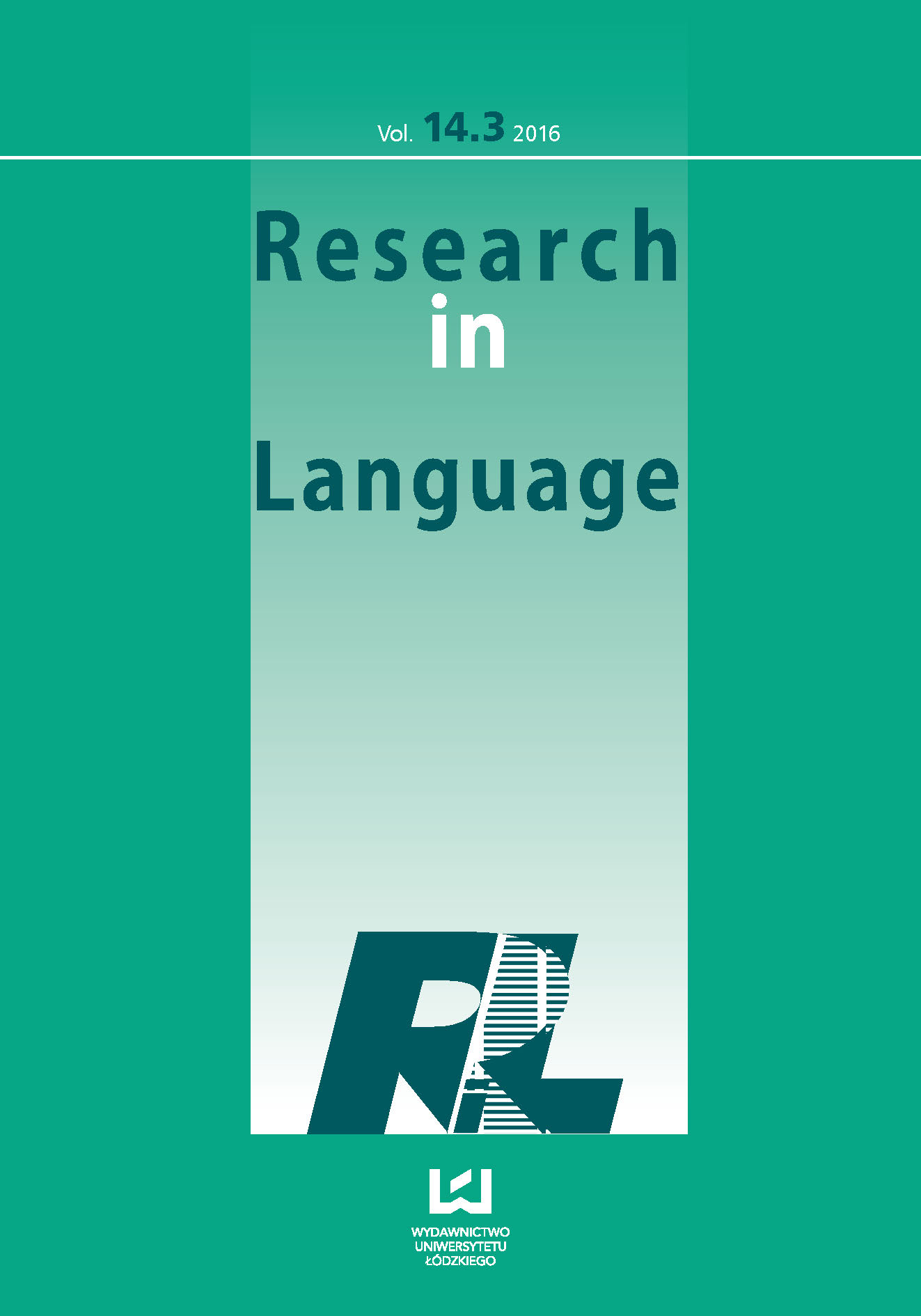Phonological development in the early speech of an Indonesian-German bilingual child
DOI:
https://doi.org/10.1515/rela-2016-0017Keywords:
phonological development, bilingual childAbstract
Current research in bilingual children’s language development with one language dominant has shown that one linguistic system can affect the other. This is called Crosslinguistic Influence (CLI). This paper explores whether CLI is experienced by a bilingual child raised in two typologically distinct languages in terms of phonological development. It uses data from the study of a child simultaneously acquiring Indonesian and German between the ages of 12 months - 20 months, with Indonesian as the dominant language. The sound segments developed by the child showed universal tendencies, with the appearance of bilabials prior to alveolar sounds, followed by velar sounds. The sounds were produced mostly in the form of stops, nasals and glides. Three phonological processes were displayed by the child: substitution, assimilation and syllable structures. The front rounded vowel [ʏ], which exists in German but not in the Indonesian sound system, was systematically replaced by the palatal approximant [j]. This approximant exists in the Indonesian sound system but not in the German phonemic inventory. This provides evidence that, in terms of phonological development, the child experienced CLI, but only for certain sound transfers.
References
Bosch, L. and Sebastian-Galles, N. 2001. Evidence of early language differentiation abilities in infants from bilingual environments. Infancy 2. 29-49.
Google Scholar
Dardjowidjojo, S. 2000. Echa: Kisah Pemerolehan Bahasa Anak Indonesia. Jakarta: PT. Gramedia Widiasarana Indonesia.
Google Scholar
De Houwer, A. 1990. Bilingual First Language Acquisition. Clevedon/Buffalo: Multilingual Matters.
Google Scholar
Deuchar, M. and Clark, A. 1996. Early Bilingual Acquisition of the Voicing Contrast in English and Spanish. Journal of Phonetics 24. 351-365.
Google Scholar
Deutchar, M, and S. Quay. 1998. One vs. Two Systems in Early Bilingual Syntax: Two Versions of the Question. Bilingualism: Language and Cognition 13. 231-243.
Google Scholar
Fikkert, P. 2007. Acquiring Phonology. In P. D. Lacy (ed.), Handbook of Phonological Theory, 537-554. Cambridge: Cambridge University Press.
Google Scholar
Genesee, F. 2001. Bilingual First Language Acquisition: Exploring the Limits of the Language Faculty. Annual Review of Applied Linguistics. 153-170.
Google Scholar
Ingram, D. 1981. Phonological patterns in the Speech of Young Children. In P. Fletcher and M. Garman (eds.), Language Acquisition: Studies in First Language Development, 133-148. Cambridge: Cambridge University Press.
Google Scholar
Ingram, D. 1992. First Language Acquisition: Method, Description, and Explanation. Cambridge: Cambridge University Press.
Google Scholar
Ingram, E. 1973. Language Development in Children. In H. Fraser and W. R. O’Donnell (eds.), Applied Linguistics and the Teaching of English, 21-36. London: Longman Group Limited.
Google Scholar
Iverson, J. M. and S. Goldin-Meadow. 2005. Gesture paves the way for language development. Psychological Science 16. 367-371.
Google Scholar
Jakobson, R. 1971. Studies on Child Language and Aphasia. The Haque: Mouton Leopold, W. F. 1978. A Child’s Learning of Two Languages. In E. M. Hatch (ed.), Second language acquistition: a Book of Readings, 23-32. Massachusetts: Newbury House Publishers.
Google Scholar
Meisel, J. M. 2001. The Simultaneous Acquisition of Two First Languages; Early Differentiation and Subsequent Development of Grammars. In F. Genesee and J. Cenoz (eds.), Trends in Language Acquisition, 11-42. Amsterdam: John Benjamins B.V.
Google Scholar
Nicoladis, E. 1998. First Clues to the Existence of Two Input Languages: Pragmatic and Lexical differentiation in Bilingual Child. Bilingualism: Language and Cognition 1 Cambridge University Press 1. 105-116.
Google Scholar
OzCalişkan, Ş. and S. Goldin-Meadow. 2005. Gesture is at the cutting edge of early language development. Cognition, Elsevier B.V. 101-113.
Google Scholar
Poulin-Dubois, D. and N. Goodz. 2001. Language Differentiation in Bilingual Infants: Evidence from Babling. In F. Genesee and J. Cenoz (eds.), Trends in Language Acquisition, 96-106. Amsterdam: John Benjamins B.V.
Google Scholar
Rowe, M. L. and S. Goldin-Meadow. 2009. Early gesture selectively predicts later language learning. Developmental Science 12. 182-187.
Google Scholar
Soriente, A. 2007. Cross-Linguistics and Cognitive Structures in the Acquisition of WH-Questions in an Indonesian-Italian Bilingual Child. In I. Kecskes and L. Albertazzi (eds.), Cognitive Aspects of Bilingualism, 325-362. Dordrecht: Spriger.
Google Scholar
Stempe, D. 1969. The acquisition of phonetic representation. In R. Binnick et al. (eds.), Papers from the Fifth Regional Meeting of the Chicago Linguistic Society, 443-444. Chicago: Chicago.
Google Scholar
Uiowa. edu. 2014. Phonetik: Die Laute des Deutschen. Available from: URL: http://www.uiowa.edu/~acadtech/phonetics/german/german.html [Accessed on:] 4th January 2014
Google Scholar
Volterra, V. and Taeschner, T. 1978. The acquisition and development of language by bilingual children. Journal of Child language 5: 311-326.
Google Scholar
Yip, V. and S. Matthews. 2007. The Bilingual Child: Early Development and Language Contact. Cambridge: Cambridge University Press.
Google Scholar
Yip, V. 2013. Simultaneous Language Acquisition. In F. Grosjean and P. Li (eds.), The Psycholinguistics of Bilingualism, 5-25. West Sussex: Wiley-Blackwell.
Google Scholar
Yulianto, B. 2009. Perkembangan Fonologis Bahasa Anak. Surabaya: Unesa University Press.
Google Scholar
Downloads
Published
How to Cite
Issue
Section
License
Copyright (c) 2016 © Copyright by Authors, Łódź 2016; © Copyright for this edition by Uniwersytet Łódzki, Łódź 2016

This work is licensed under a Creative Commons Attribution-NonCommercial-NoDerivatives 4.0 International License.










